The Analysis Report For the Case “Heineken N.V.:

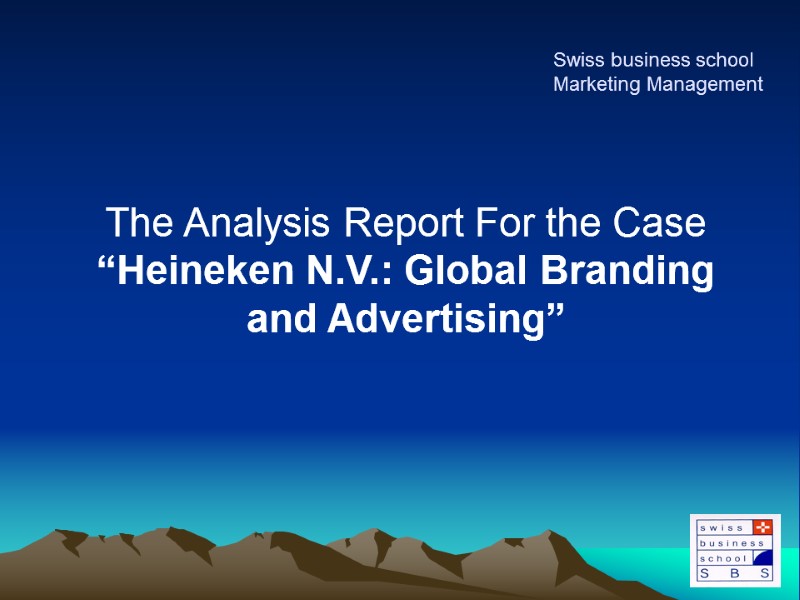
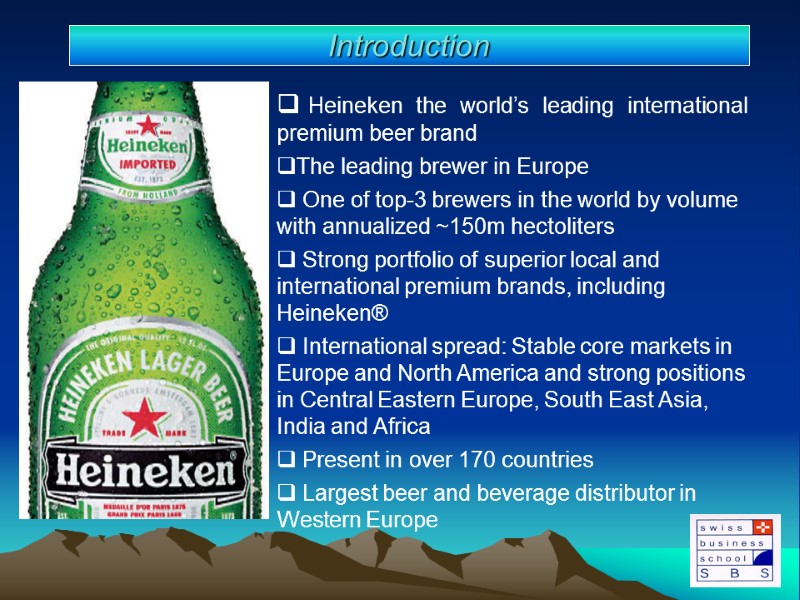
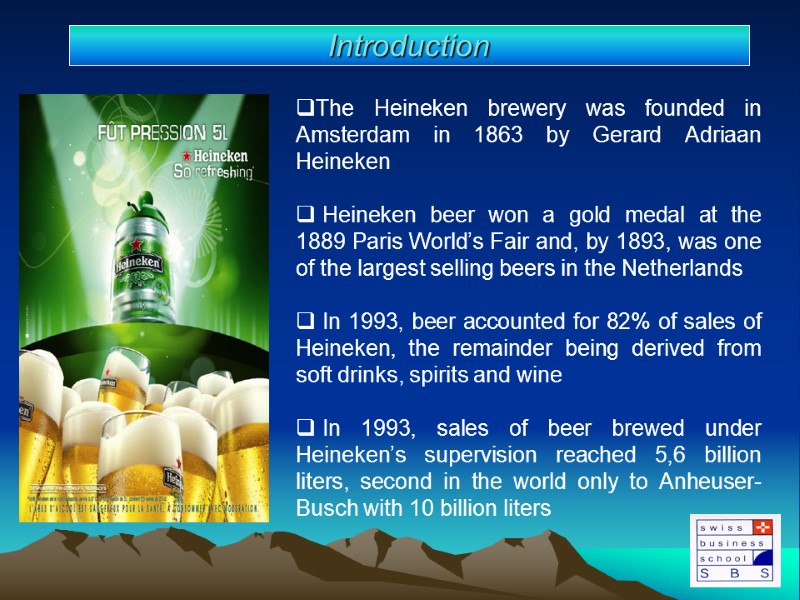
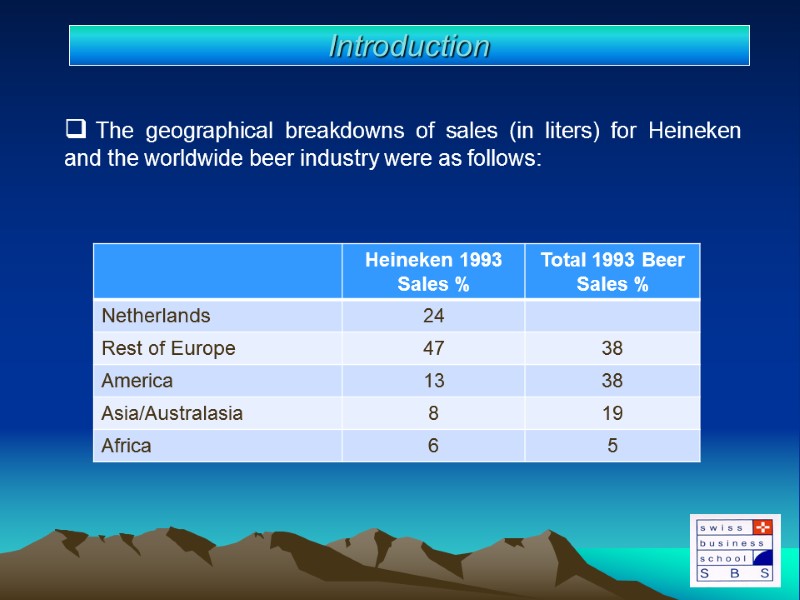
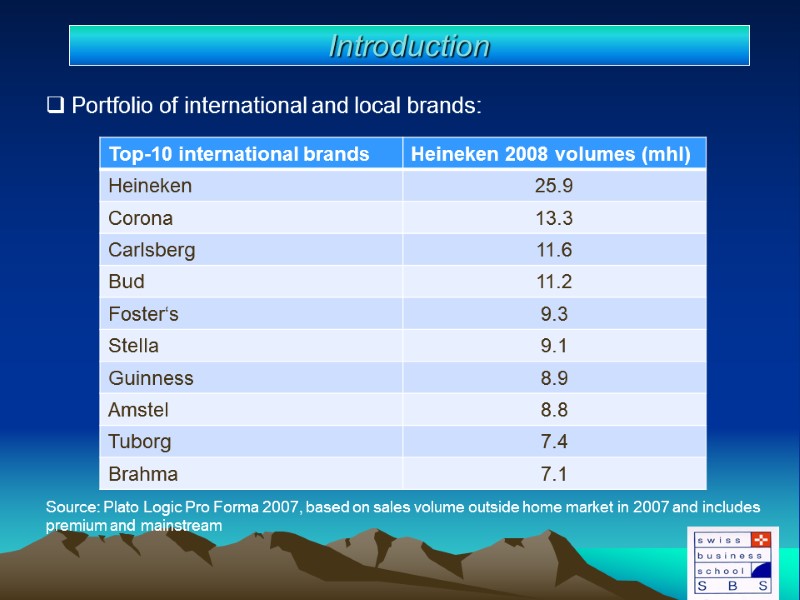

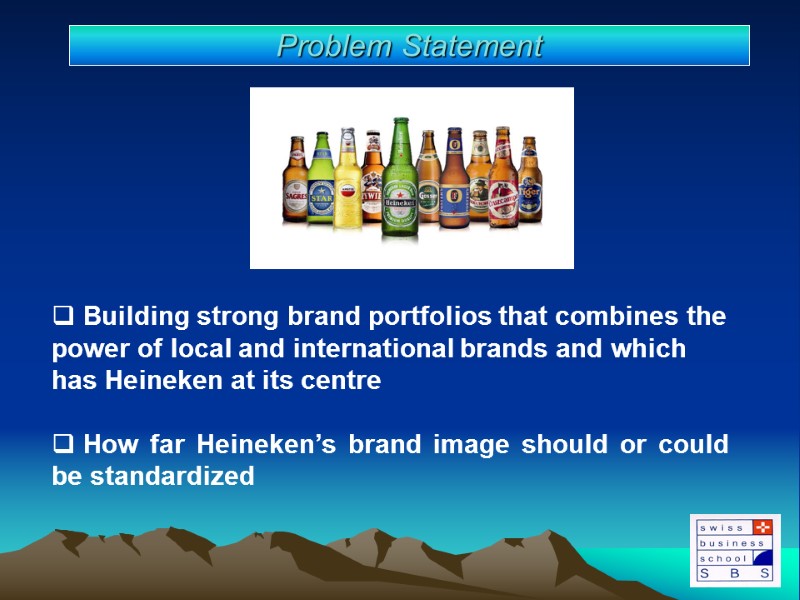
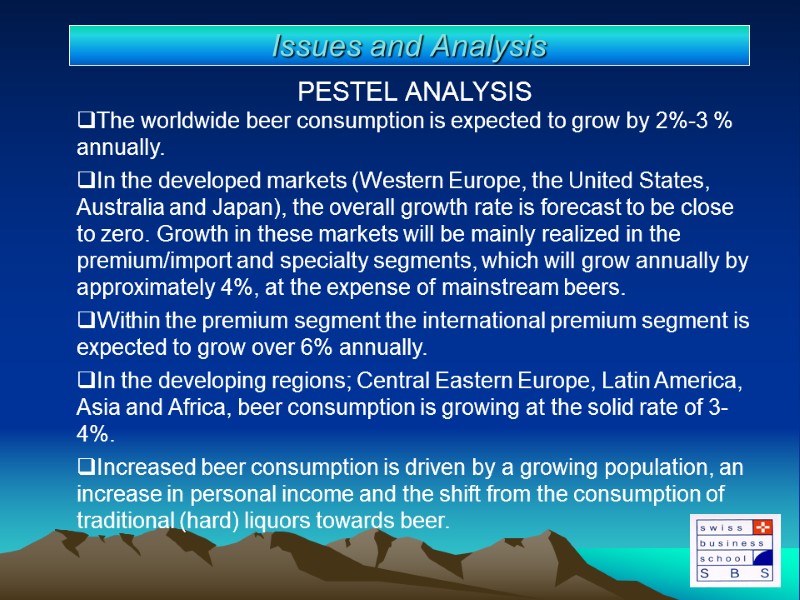
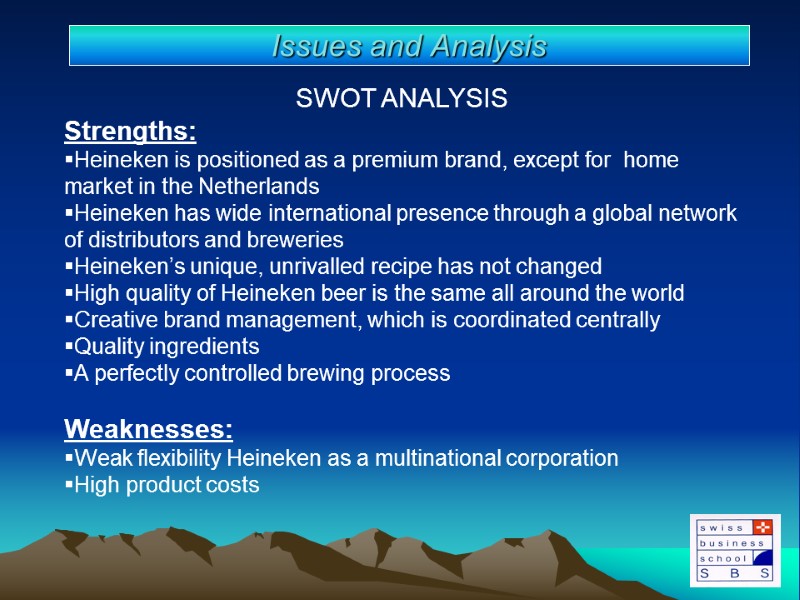


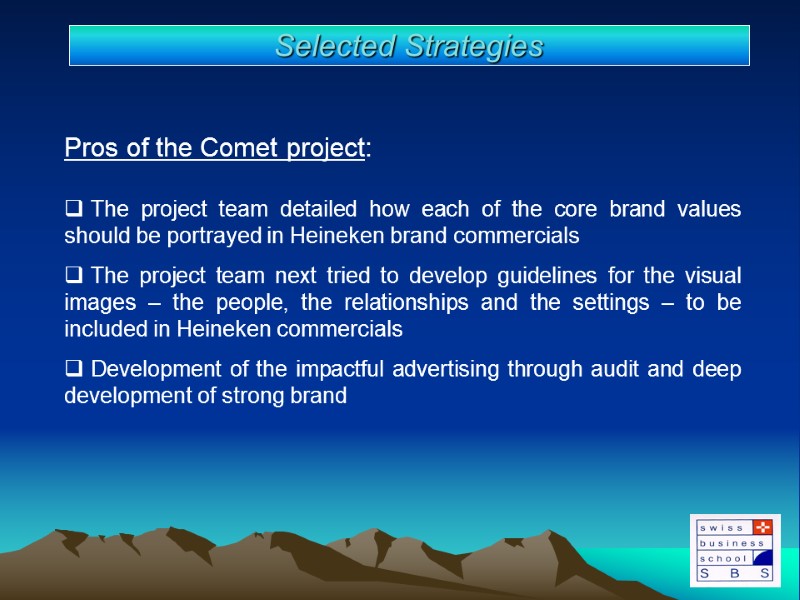
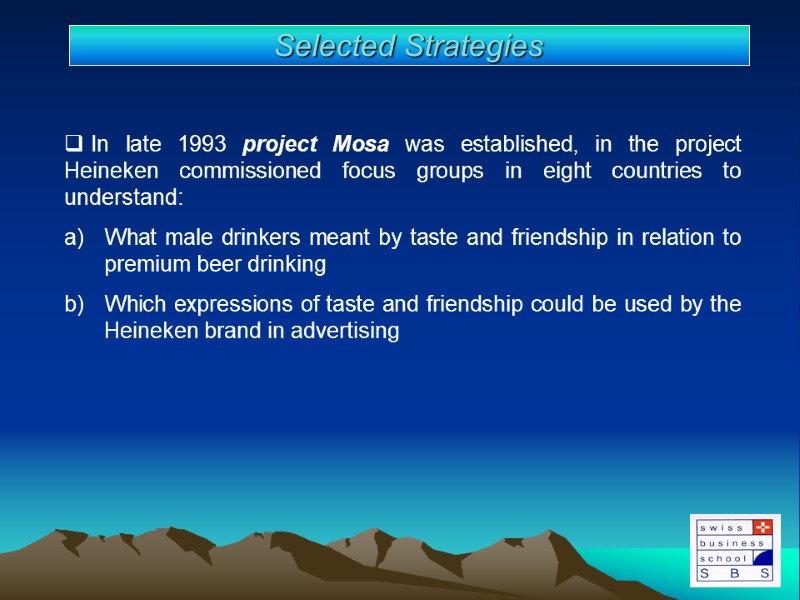
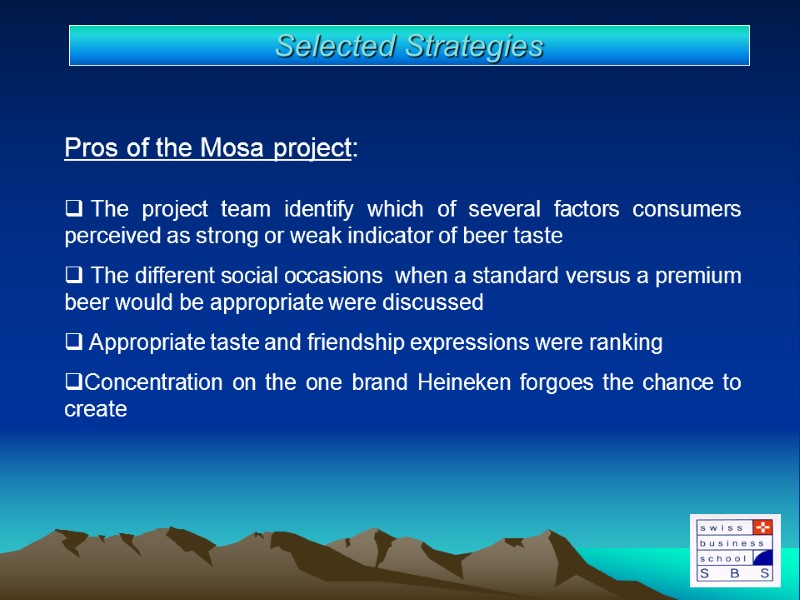
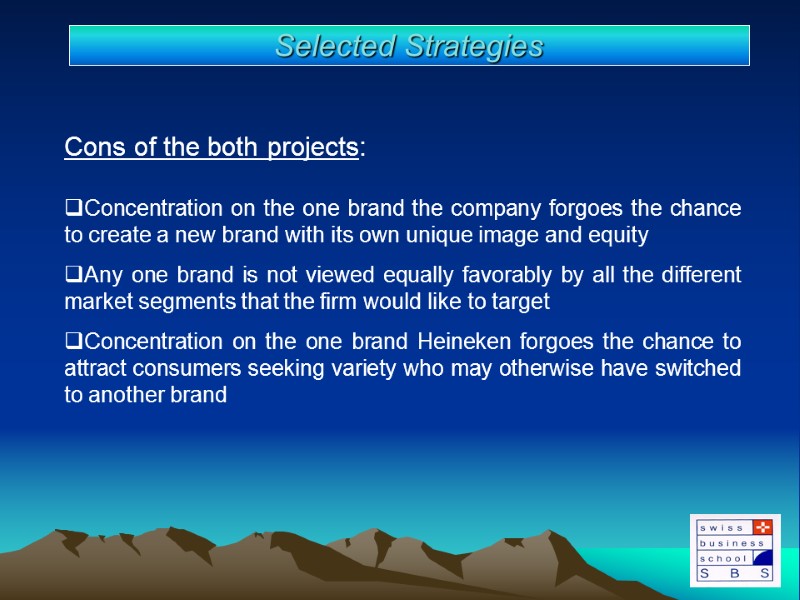


11214-the_analysis_heineken_case_example.ppt
- Количество слайдов: 17
 The Analysis Report For the Case “Heineken N.V.: Global Branding and Advertising” Swiss business school Marketing Management
The Analysis Report For the Case “Heineken N.V.: Global Branding and Advertising” Swiss business school Marketing Management
 Heineken the world’s leading international premium beer brand The leading brewer in Europe One of top-3 brewers in the world by volume with annualized ~150m hectoliters Strong portfolio of superior local and international premium brands, including Heineken® International spread: Stable core markets in Europe and North America and strong positions in Central Eastern Europe, South East Asia, India and Africa Present in over 170 countries Largest beer and beverage distributor in Western Europe Introduction
Heineken the world’s leading international premium beer brand The leading brewer in Europe One of top-3 brewers in the world by volume with annualized ~150m hectoliters Strong portfolio of superior local and international premium brands, including Heineken® International spread: Stable core markets in Europe and North America and strong positions in Central Eastern Europe, South East Asia, India and Africa Present in over 170 countries Largest beer and beverage distributor in Western Europe Introduction
 Introduction The Heineken brewery was founded in Amsterdam in 1863 by Gerard Adriaan Heineken Heineken beer won a gold medal at the 1889 Paris World’s Fair and, by 1893, was one of the largest selling beers in the Netherlands In 1993, beer accounted for 82% of sales of Heineken, the remainder being derived from soft drinks, spirits and wine In 1993, sales of beer brewed under Heineken’s supervision reached 5,6 billion liters, second in the world only to Anheuser-Busch with 10 billion liters
Introduction The Heineken brewery was founded in Amsterdam in 1863 by Gerard Adriaan Heineken Heineken beer won a gold medal at the 1889 Paris World’s Fair and, by 1893, was one of the largest selling beers in the Netherlands In 1993, beer accounted for 82% of sales of Heineken, the remainder being derived from soft drinks, spirits and wine In 1993, sales of beer brewed under Heineken’s supervision reached 5,6 billion liters, second in the world only to Anheuser-Busch with 10 billion liters
 The geographical breakdowns of sales (in liters) for Heineken and the worldwide beer industry were as follows: Introduction
The geographical breakdowns of sales (in liters) for Heineken and the worldwide beer industry were as follows: Introduction
 Introduction Portfolio of international and local brands: Source: Plato Logic Pro Forma 2007, based on sales volume outside home market in 2007 and includes premium and mainstream
Introduction Portfolio of international and local brands: Source: Plato Logic Pro Forma 2007, based on sales volume outside home market in 2007 and includes premium and mainstream
 Introduction Heineken was the most heavily advertised premium brand in Europe and worldwide. Comparative Heineken Usage Data for Seven European Markets:
Introduction Heineken was the most heavily advertised premium brand in Europe and worldwide. Comparative Heineken Usage Data for Seven European Markets:
 Building strong brand portfolios that combines the power of local and international brands and which has Heineken at its centre How far Heineken’s brand image should or could be standardized Problem Statement
Building strong brand portfolios that combines the power of local and international brands and which has Heineken at its centre How far Heineken’s brand image should or could be standardized Problem Statement
 PESTEL ANALYSIS The worldwide beer consumption is expected to grow by 2%-3 % annually. In the developed markets (Western Europe, the United States, Australia and Japan), the overall growth rate is forecast to be close to zero. Growth in these markets will be mainly realized in the premium/import and specialty segments, which will grow annually by approximately 4%, at the expense of mainstream beers. Within the premium segment the international premium segment is expected to grow over 6% annually. In the developing regions; Central Eastern Europe, Latin America, Asia and Africa, beer consumption is growing at the solid rate of 3-4%. Increased beer consumption is driven by a growing population, an increase in personal income and the shift from the consumption of traditional (hard) liquors towards beer. Issues and Analysis
PESTEL ANALYSIS The worldwide beer consumption is expected to grow by 2%-3 % annually. In the developed markets (Western Europe, the United States, Australia and Japan), the overall growth rate is forecast to be close to zero. Growth in these markets will be mainly realized in the premium/import and specialty segments, which will grow annually by approximately 4%, at the expense of mainstream beers. Within the premium segment the international premium segment is expected to grow over 6% annually. In the developing regions; Central Eastern Europe, Latin America, Asia and Africa, beer consumption is growing at the solid rate of 3-4%. Increased beer consumption is driven by a growing population, an increase in personal income and the shift from the consumption of traditional (hard) liquors towards beer. Issues and Analysis
 SWOT ANALYSIS Strengths: Heineken is positioned as a premium brand, except for home market in the Netherlands Heineken has wide international presence through a global network of distributors and breweries Heineken’s unique, unrivalled recipe has not changed High quality of Heineken beer is the same all around the world Creative brand management, which is coordinated centrally Quality ingredients A perfectly controlled brewing process Weaknesses: Weak flexibility Heineken as a multinational corporation High product costs Issues and Analysis
SWOT ANALYSIS Strengths: Heineken is positioned as a premium brand, except for home market in the Netherlands Heineken has wide international presence through a global network of distributors and breweries Heineken’s unique, unrivalled recipe has not changed High quality of Heineken beer is the same all around the world Creative brand management, which is coordinated centrally Quality ingredients A perfectly controlled brewing process Weaknesses: Weak flexibility Heineken as a multinational corporation High product costs Issues and Analysis
 SWOT ANALYSIS Opportunities: Developing international markets Mergers, joint ventures, or strategic alliance Removal an international trade barriers Threats: High activity of competitors Price war World crisis Issues and Analysis
SWOT ANALYSIS Opportunities: Developing international markets Mergers, joint ventures, or strategic alliance Removal an international trade barriers Threats: High activity of competitors Price war World crisis Issues and Analysis
 Project Comet was established in 1991 to recommend how to enhance Heineken’s competitive advantage by more consistently the brand as “the world’s leading premium beer” The project team concluded that Heineken’s desired brand image was “good taste” The brand’s good taste image would be built on five core brand values: Taste Premiumness Tradition Winning spirit Friendship Selected Strategies
Project Comet was established in 1991 to recommend how to enhance Heineken’s competitive advantage by more consistently the brand as “the world’s leading premium beer” The project team concluded that Heineken’s desired brand image was “good taste” The brand’s good taste image would be built on five core brand values: Taste Premiumness Tradition Winning spirit Friendship Selected Strategies
 Pros of the Comet project: The project team detailed how each of the core brand values should be portrayed in Heineken brand commercials The project team next tried to develop guidelines for the visual images – the people, the relationships and the settings – to be included in Heineken commercials Development of the impactful advertising through audit and deep development of strong brand Selected Strategies
Pros of the Comet project: The project team detailed how each of the core brand values should be portrayed in Heineken brand commercials The project team next tried to develop guidelines for the visual images – the people, the relationships and the settings – to be included in Heineken commercials Development of the impactful advertising through audit and deep development of strong brand Selected Strategies
 In late 1993 project Mosa was established, in the project Heineken commissioned focus groups in eight countries to understand: What male drinkers meant by taste and friendship in relation to premium beer drinking Which expressions of taste and friendship could be used by the Heineken brand in advertising Selected Strategies
In late 1993 project Mosa was established, in the project Heineken commissioned focus groups in eight countries to understand: What male drinkers meant by taste and friendship in relation to premium beer drinking Which expressions of taste and friendship could be used by the Heineken brand in advertising Selected Strategies
 Pros of the Mosa project: The project team identify which of several factors consumers perceived as strong or weak indicator of beer taste The different social occasions when a standard versus a premium beer would be appropriate were discussed Appropriate taste and friendship expressions were ranking Concentration on the one brand Heineken forgoes the chance to create Selected Strategies
Pros of the Mosa project: The project team identify which of several factors consumers perceived as strong or weak indicator of beer taste The different social occasions when a standard versus a premium beer would be appropriate were discussed Appropriate taste and friendship expressions were ranking Concentration on the one brand Heineken forgoes the chance to create Selected Strategies
 Cons of the both projects: Concentration on the one brand the company forgoes the chance to create a new brand with its own unique image and equity Any one brand is not viewed equally favorably by all the different market segments that the firm would like to target Concentration on the one brand Heineken forgoes the chance to attract consumers seeking variety who may otherwise have switched to another brand Selected Strategies
Cons of the both projects: Concentration on the one brand the company forgoes the chance to create a new brand with its own unique image and equity Any one brand is not viewed equally favorably by all the different market segments that the firm would like to target Concentration on the one brand Heineken forgoes the chance to attract consumers seeking variety who may otherwise have switched to another brand Selected Strategies
 How to identify and establish brand positioning How to plan and implement brand marketing How to measure and interpret brand performance What are the important decisions in developing a branding strategy Lessons learnt
How to identify and establish brand positioning How to plan and implement brand marketing How to measure and interpret brand performance What are the important decisions in developing a branding strategy Lessons learnt
 In general, the basic principle in designing a brand portfolio is to maximize market coverage, so that no potential customers are being ignored, but to minimize brand overlap, so brands are not competing to gain customer approval Thanks for your attention! Conclusion
In general, the basic principle in designing a brand portfolio is to maximize market coverage, so that no potential customers are being ignored, but to minimize brand overlap, so brands are not competing to gain customer approval Thanks for your attention! Conclusion

